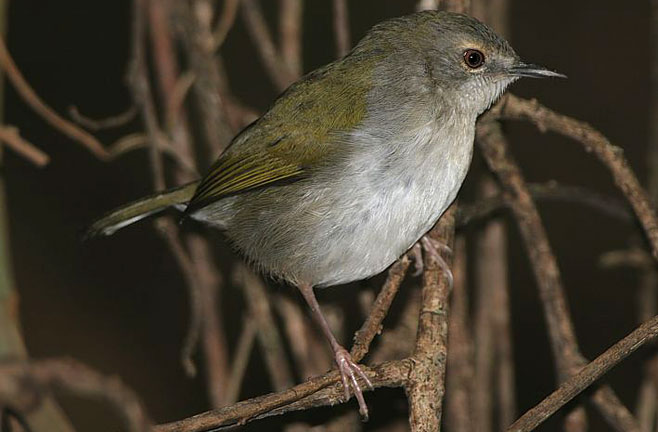|
Camaroptera brachyura
(Green-backed camaroptera, Bleating warbler)
Groenrugkwękwęvoël [Afrikaans]; Kwę-kwęvoël
[Afrikaans]; Unomanyuku, Unome [Xhosa]; iMbuzi-yehlathi, umBuzana [Zulu]; Niini
(generic term for warblers and eremomelas) [Kwangali]; Mekker-camaroptera
[Dutch]; Camaroptčre ŕ tęte grise [French]; Meckergrasmücke (Grünrücken-camaroptera,
Graurücken-camaroptera) [German]; Felosa-de-dorso-verde [Portuguese]
Life
> Eukaryotes >
Opisthokonta
> Metazoa (animals) >
Bilateria >
Deuterostomia > Chordata >
Craniata > Vertebrata (vertebrates) > Gnathostomata (jawed
vertebrates) > Teleostomi (teleost fish) > Osteichthyes (bony fish) > Class:
Sarcopterygii (lobe-finned
fish) > Stegocephalia (terrestrial
vertebrates) > Tetrapoda
(four-legged vertebrates) > Reptiliomorpha > Amniota >
Reptilia (reptiles) >
Romeriida > Diapsida > Archosauromorpha > Archosauria >
Dinosauria
(dinosaurs) > Saurischia > Theropoda (bipedal predatory dinosaurs) >
Coelurosauria > Maniraptora > Aves
(birds) >
Order: Passeriformes > Family: Cisticolidae
> Genus: Cameroptera
 |
|
Green-backed camaroptera, Nature's Valley, South
Africa. [photo Trevor Hardaker ©] |
Distribution and habitat
Endemic to southern Africa, occurring from southern
Mozambique to the Limpopo Province, Mpumalanga, Swaziland, KwaZulu-Natal and the
Eastern Cape. It generally prefers moist bush near watercourses in savanna
woodland, also occurring along forest edges, gardens and parks.
Brood parasites
It has been recorded as host of the
African emerald cuckoo.
Food
It mainly eats invertebrates, doing most of its foraging in
the forest undergrowth, often catching prey disturbed by humans.
Breeding
- The nest is built by both sexes, consisting of a ball-shaped structure
made of leaves attached together with spider web, lined with finer material
such as grass. It is typically placed in a clump of grass, low shrub or
sapling, anwhere from ground level to about 2, rarely up to 6 metres up.
- Egg-laying season is from September-February, peaking from
October-December.
- It lays 2-4 eggs, which are incubated by both sexes for about 14-15
days.
- The chicks are fed by both adults, staying in the nest for roughly 14-15
days.
Threats
Not threatened, although it is does not fend well in
disturbed habitats.
References
-
Hockey PAR, Dean WRJ and Ryan PG 2005. Roberts - Birds of
southern Africa, VIIth ed. The Trustees of the John Voelcker Bird Book
Fund, Cape Town.
|
